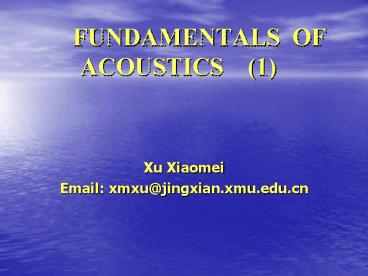FUNDAMENTALS OF ACOUSTICS 1 - PowerPoint PPT Presentation
1 / 20
Title:
FUNDAMENTALS OF ACOUSTICS 1
Description:
An understanding of basic mathematics,the fundamental principles of mechanics, ... height screens), light fixtures, furniture, etc. These obstacles change the path ... – PowerPoint PPT presentation
Number of Views:52
Avg rating:3.0/5.0
Title: FUNDAMENTALS OF ACOUSTICS 1
1
FUNDAMENTALS OF ACOUSTICS (1)
- Xu Xiaomei
- Email xmxu_at_jingxian.xmu.edu.cn
2
- Prerequisites
- An understanding of basic mathematics,the
fundamental principles of mechanics,
electricity,and access to a scientific calculator
3
- Objective
- Throughout the course emphasis is placed on
fundamentals, with discussions and problems
extending into some phases and applications of
acoustics
4
- The generation, transmission and reception of
acoustic waves - On completion of this course students will be
able to understand the terms used to describe
sound waves, the generation, transmission, and
reception of acoustic waves and their application
to numerous fields the relationship between
sound pressure, sound intensity and sound power
and the terms used to describe sound fields.
5
- contents
- Introduction
- What sound is caused by
- what a sound wave is
- what a cycle is .
6
(No Transcript)
7
Any sound, whatever it might be, is caused by
something vibrating. Without vibration there can
be no sound. The vibrating body causes the air
particles next to it to vibrate those air
particles, in turn, cause the particles next to
them to vibrate. In this way a disturbance of the
air moves out from the source of the sound and
may eventually reach the ears of a listener.
8
The transmitting medium
When we hear a sound, air vibrates against our
eardrums causing them to vibrate also. These
vibrations are detected and analyzed by our
brains. Although it is usually air that acts as
the transmitting medium, sound can be transmitted
by other media, e.g. water, building structures
9
Sound wave
Sound does not consist of air moving towards us
in bulk it travels through the air as a sound
wave. A sound wave consists of a disturbance
moving out from a source to surrounding places
with the result that energy is transferred from
one place to another.
10
Compressions and rarefactions
As the wave passes, the disturbance of particles
is in the direction of the wave travel. The
displacement of particles of the medium results
in alternate regions of high particle density and
low particle density. Regions of high particle
density are called compressions. Regions of low
particle density are called rarefactions.
11
a cycle
Rarefactions and compressions both move in the
direction of the wave travel. The particles of
the medium do not move bodily in the direction of
the wave movement they vibrate about their
normal positions. Each complete vibration of a
particle is called a cycle ( i.e. from its
starting position, to a maximum distance in one
direction, back through the starting position,
then to a maximum displacement in the opposite
direction and back to the starting place).
12
transmission
13
(No Transcript)
14
(No Transcript)
15
- Spreading occurs as the sound expands in
spherical waves. The sound level decreases as the
distance from the source becomes larger
16
- Scattering occurs as the wave direction changes
through diffraction or reflection - Absorption occurs as the sound enters a porous
material and gets trapped in the air pockets. The
trapped sound energy is converted to other forms
of energy
17
18
(No Transcript)
19
(No Transcript)
20
Examples noise at works






























![[PDF] Fundamentals of Phonetics: A Practical Guide for Students 6th Edition Ipad PowerPoint PPT Presentation](https://s3.amazonaws.com/images.powershow.com/10077867.th0.jpg?_=20240712086)
